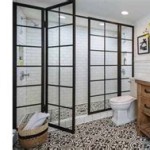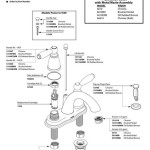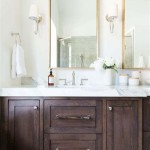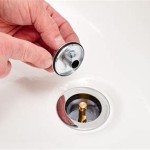Amazing Bathroom Sinks and Cabinets: A Comprehensive Guide
The bathroom, often considered a sanctuary for personal hygiene, requires careful consideration in its design and functionality. Among the key elements contributing to both aesthetics and practicality are the bathroom sink and cabinet. Selecting the right sink and cabinet combination involves evaluating several factors, including available space, desired style, storage needs, and budget. This article provides a comprehensive guide to understanding the various options available and making informed decisions regarding bathroom sinks and cabinets.
Types of Bathroom Sinks
Bathroom sinks come in a variety of styles, each with its own advantages and disadvantages. Understanding the differences between these styles is crucial in selecting the most suitable option for a specific bathroom.
Undermount Sinks: Undermount sinks are installed beneath the countertop, creating a seamless and clean look. The edges of the sink are attached to the underside of the countertop, resulting in a smooth surface that is easy to clean. This type of sink is particularly well-suited for modern and minimalist designs. The primary benefit of an undermount sink is the ease of cleaning the countertop, as there are no rims or edges to trap dirt and debris. However, undermount sinks typically require a solid surface countertop, such as granite or quartz, which can increase the overall cost. Installation can also be more complex compared to other sink types.
Vessel Sinks: Vessel sinks, also known as above-counter sinks, sit on top of the countertop, resembling a bowl. They are available in a wide range of shapes, sizes, and materials, offering a visually striking focal point for the bathroom. Vessel sinks can add a touch of elegance and uniqueness to a bathroom design. Installation is usually straightforward, as it typically involves simply placing the sink on the countertop and connecting the plumbing. However, vessel sinks can be more prone to splashing and may require a taller faucet to accommodate the height of the sink. The countertop height may also need to be adjusted to ensure comfortable use.
Pedestal Sinks: Pedestal sinks consist of a sink bowl mounted on a freestanding pedestal base. They are a classic and space-saving option, particularly suitable for smaller bathrooms or powder rooms. Pedestal sinks offer a clean and elegant aesthetic. They are relatively easy to install and can be a cost-effective choice. However, pedestal sinks offer limited storage space, making them less practical for bathrooms where storage is a priority.
Console Sinks: Console sinks combine a sink basin with a supporting frame, often made of metal or wood. They offer a compromise between the space-saving design of a pedestal sink and the storage capabilities of a vanity. Console sinks can provide a stylish and functional solution for bathrooms of various sizes. They often feature a shelf or two beneath the sink, providing some storage space for toiletries or towels. However, the storage capacity is generally less than that of a full vanity.
Wall-Mounted Sinks: Wall-mounted sinks, as the name suggests, are attached directly to the wall, without a countertop or pedestal. They create a minimalist and modern look, and they can be installed at a custom height to accommodate different users. Wall-mounted sinks are particularly useful for small bathrooms or accessible bathrooms, as they free up floor space. However, they offer no integrated storage and require careful planning for plumbing connections to ensure they are concealed within the wall.
Integrated Sinks: Integrated sinks are seamlessly molded into the countertop, creating a single, continuous surface. They are typically made of materials such as solid surface, acrylic, or cultured marble. Integrated sinks offer a sleek and modern look and are easy to clean. They eliminate the seams found in other sink types, reducing the risk of leaks and making them hygienic. However, the design options may be more limited compared to other sink types.
Types of Bathroom Cabinets
Bathroom cabinets are essential for storage and organization, helping to keep the bathroom clutter-free and functional. Choosing the right type of cabinet depends on the available space, storage needs, and desired aesthetic.
Vanity Cabinets: Vanity cabinets are the most common type of bathroom cabinet. They combine a sink and a cabinet base, providing both a sink area and storage space. Vanity cabinets come in a wide range of sizes, styles, and materials, making it possible to find an option that suits almost any bathroom design. The storage space within a vanity cabinet can be used to store toiletries, towels, cleaning supplies, and other bathroom essentials. Vanity cabinets can be freestanding or wall-mounted.
Wall Cabinets: Wall cabinets are mounted to the wall and provide storage above the sink or toilet. They are a great option for maximizing vertical space and keeping items within easy reach. Wall cabinets are available in various sizes and styles, including mirrored cabinets, which can double as a mirror. They can be particularly useful for storing medications, toiletries, and other small items. It is essential to ensure that wall cabinets are securely mounted to the wall to prevent them from falling.
Linen Cabinets: Linen cabinets are tall, narrow cabinets that are designed to store towels, linens, and other bathroom essentials. They are typically placed along a wall and can provide ample storage space, even in smaller bathrooms. Linen cabinets can be freestanding or built-in. They often feature adjustable shelves, allowing for customization of the storage space. Choosing a linen cabinet that complements the overall bathroom design can enhance the aesthetic appeal of the space.
Over-the-Toilet Cabinets: Over-the-toilet cabinets are designed to fit over the toilet, utilizing the often-unused space above the toilet. They provide additional storage space without taking up valuable floor space. Over-the-toilet cabinets typically feature shelves or enclosed compartments. They are a practical solution for small bathrooms where storage space is limited. When selecting an over-the-toilet cabinet, it is important to ensure that it fits properly over the toilet and provides sufficient clearance.
Freestanding Cabinets: Freestanding cabinets are stand-alone units that can be placed anywhere in the bathroom. They offer flexibility in placement and can be easily moved if needed. Freestanding cabinets are available in various shapes, sizes, and styles. They can be used to store a variety of items, from towels and toiletries to cleaning supplies and decorative items. Choosing a freestanding cabinet that complements the overall bathroom design can enhance the aesthetic appeal of the space.
Factors to Consider When Choosing Sinks and Cabinets
Selecting the right bathroom sink and cabinet involves considering several key factors to ensure that the chosen products meet specific needs and preferences.
Space and Layout: The available space and the layout of the bathroom are crucial considerations. Smaller bathrooms may require space-saving solutions, such as pedestal sinks, wall-mounted sinks, or compact vanity cabinets. Larger bathrooms may accommodate larger vanities, linen cabinets, and other storage options. Measuring the available space accurately is essential to ensure that the chosen sink and cabinet will fit properly without overcrowding the bathroom.
Style and Design: The style and design of the sink and cabinet should complement the overall aesthetic of the bathroom. Modern bathrooms may benefit from sleek, minimalist designs, while traditional bathrooms may call for more ornate or classic styles. Consider the color scheme, materials, and finishes of the sink and cabinet to ensure that they blend seamlessly with the rest of the bathroom decor. Coordinating the style and design of the sink and cabinet with other bathroom fixtures, such as the toilet, shower, and lighting, can create a cohesive and visually appealing space.
Storage Needs: Assessing storage needs is crucial in selecting the right type of bathroom cabinet. Consider the amount of storage space required for toiletries, towels, cleaning supplies, and other bathroom essentials. Vanity cabinets offer the most storage space, while pedestal sinks and wall-mounted sinks offer minimal storage. Linen cabinets and wall cabinets can be added to supplement storage space if needed. Organizing the storage space within the cabinet with shelves, drawers, and dividers can enhance functionality and keep the bathroom clutter-free.
Materials and Durability: The materials used in the construction of the sink and cabinet should be durable and resistant to moisture and humidity. Common materials for sinks include porcelain, ceramic, glass, and stainless steel. Countertops can be made of granite, quartz, marble, or laminate. Cabinets can be made of wood, MDF, or plywood. Selecting high-quality materials can ensure that the sink and cabinet will withstand the rigors of daily use and last for many years. Consider the ease of cleaning and maintenance when selecting materials. Non-porous materials are generally easier to clean and less prone to staining or damage.
Budget: Establishing a budget before starting the selection process can help narrow down the options and prevent overspending. Bathroom sinks and cabinets range in price from affordable to high-end. Consider the cost of the sink, cabinet, countertop, faucet, and installation. Shopping around and comparing prices from different retailers can help find the best deals. Investing in high-quality materials and construction can be a worthwhile investment in the long run, as it can reduce the need for repairs or replacements in the future.
Installation: The installation process should be considered when selecting a bathroom sink and cabinet. Some sinks and cabinets can be easily installed by a homeowner, while others may require professional installation. Complex installations, such as undermount sinks or wall-mounted cabinets, may require the expertise of a plumber or contractor. Factor in the cost of installation when budgeting for the project. Ensure that the installation is done properly to prevent leaks or other problems.
Accessibility: Accessibility is an important consideration for individuals with mobility issues or disabilities. Wall-mounted sinks can be installed at a custom height to accommodate wheelchair users. Vanity cabinets with open space underneath can also provide easier access. Lever-handled faucets are easier to operate than traditional knob faucets. Ensuring that the bathroom is accessible can make it more comfortable and convenient for all users.
Ultimately, selecting the perfect bathroom sink and cabinet requires careful consideration of individual needs, preferences, and budget. By understanding the various options available and taking into account the key factors outlined in this guide, one can create a bathroom that is both functional and aesthetically pleasing.

8 Beautiful Double Bathroom Vanity Ideas Oppein

Bathroom Vanity Styles To Fit Your Space Forbes Home

31 Black White Floating Bathroom Vanity Faux Marble Top Ceramic Vessel Sink Homary

Beautiful Bathroom Vanity Ideas Forbes Home

15 Stunning Bathroom Ideas 2024 Best Designs

10 Stunning Bathroom Cabinet Designs For A Small Space
:max_bytes(150000):strip_icc()/258105_9352cff4942f41ca9a569fd19719f30cmv2-1dbb8e2d34e447f1a8ec34f831615b76-37ea3a19ffd34f79b043ef86535a3778.jpeg?strip=all)
26 Bathroom Vanity Ideas That Are Stylish And Functional

40 Bathroom Vanities You Ll Love For Every Style

51 Bathroom Sinks That Are Overflowing With Stylistic Charm

Buy Classic Bathroom Vanity Designs Single Sink Fuao
Related Posts







